Strong visibility in different buying cycle phases is the goal everyone wants to achieve with a B2B SEO strategy.
B2B businesses buy from each other rather than presenting products and services in a way that stimulates excitement in the audience.
Like a B2C SEO strategy, it also works on the same principles often mentioned in the SEO basics.
In this blog, we aim to put forward the things you are likely to skip while planning a B2B SEO strategy.
So, let’s quickly move to the important steps for an incredible B2B marketing strategy.
Components of a B2B SEO Strategy
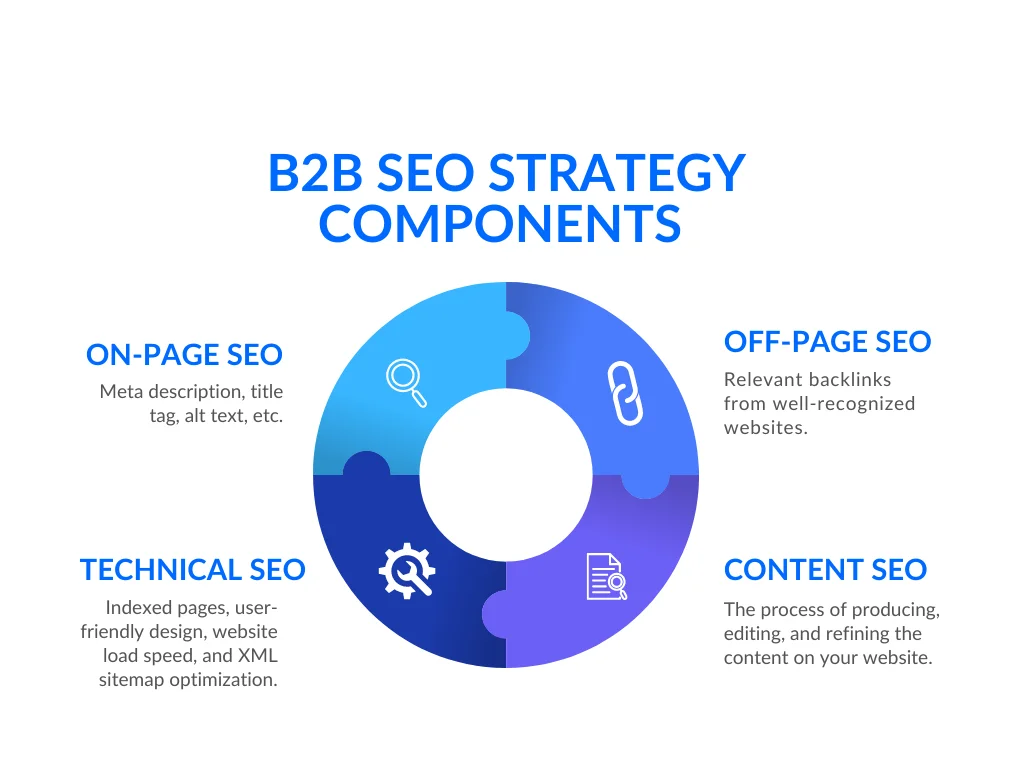 Regardless of the similarities, a B2C and B2B SEO strategy is different.
Regardless of the similarities, a B2C and B2B SEO strategy is different.
Therefore, it is vital to comprehend your intended audience’s distinct requirements, objectives, and obstacles and customize your content, keywords, and technical elements.
Optimizing a website involves several components to acquire organic traffic and good rankings.
The four main categories of SEO that require your undivided attention are:
- On-Page SEO: It involves optimizing things like the meta description, title tag, alt text, photos, and videos.
- Off-page SEO: It entails getting backlinks from well-recognized websites that are relevant to your content.
- Technical SEO: This includes things like indexed pages, user-friendly design, website load speed, and XML sitemap optimization.
- Content SEO: It is the process of producing, editing, and refining the content on your website following user intent and client needs.
Create & Plan a Phenomenal B2B SEO Strategy
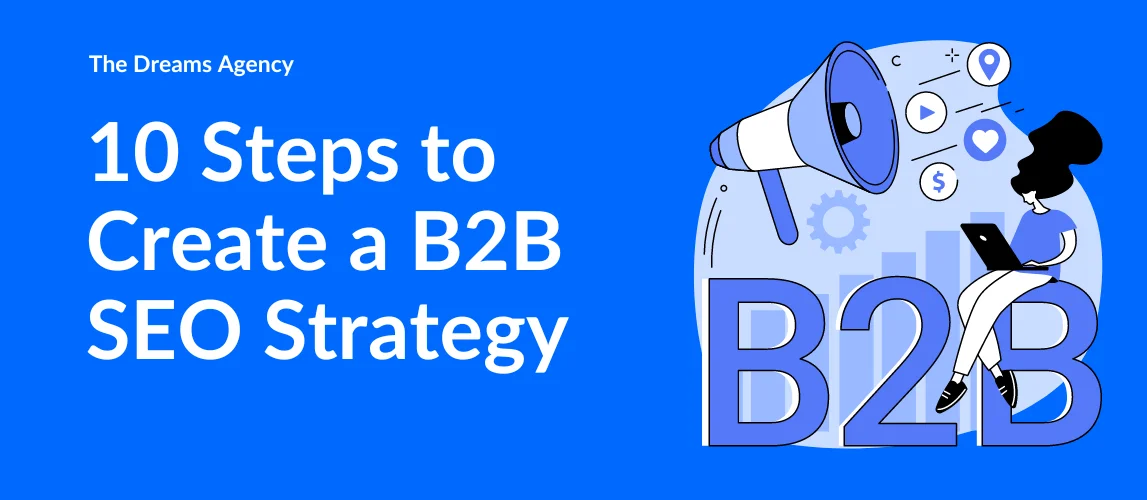 While planning an SEO strategy, a lot of companies fall for the SEO myths. As an outcome of this, all their hard work goes down the drain.
While planning an SEO strategy, a lot of companies fall for the SEO myths. As an outcome of this, all their hard work goes down the drain.
Considering that, we’ll be answering some of the SEO FAQs and elaborating on the steps that should be a definitive part of your B2B SEO strategy.
1. Recognize the Funnel for B2B Marketing
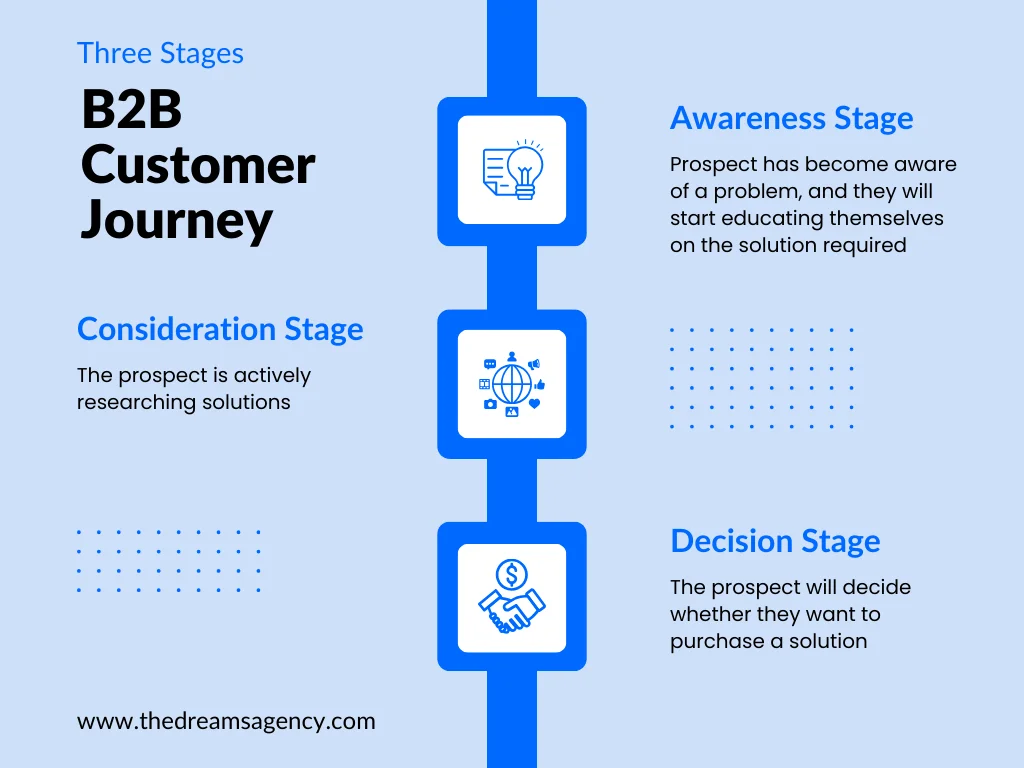 Refer to the B2B marketing funnel to help you convert prospects into clients. In the funnel, SEO is essential since it convinces visitors to become clients. It is a blueprint that drives tangible action that works for revenue generation.
Refer to the B2B marketing funnel to help you convert prospects into clients. In the funnel, SEO is essential since it convinces visitors to become clients. It is a blueprint that drives tangible action that works for revenue generation.
The B2B funnel can be split into six stages:
Awareness: Make an introduction without appearing too salesy since people are just now learning about your company.
Interest: Your goal at this point is to get people’s interest in your goods or services. From beautiful designs to email marketing, there are several ways to do it. For instance, 77% of consumers make purchase decisions because of referrals.
Consideration: To convince your audience to think of you as a potential solution, begin by educating them about your goods or services.
Intent: At this point, you want to aggressively encourage consumers to purchase from you by giving them irresistible offers like free trials.
Evaluation: People weigh the alternatives to choose the one that fulfils their needs. To get ideal customers, you need to evaluate the market and be the ideal service provider.
Purchase: You want to encourage the audience to make the last step and convert. You need to reassure them that the purchase is rational by showing a high level of commitment to them.
The buyer’s journey can be better understood by using the marketing funnel model. Envision a funnel with a broad top and a narrow bottom.
B2B SEO strategy forms a long-lasting relationship between the business and the clients.
Hence, you need to give them post-purchase support, too.
2. Look For Low Volume Keywords
Because B2B transactions usually include a more careful and deliberate decision-making process than B2C sales, B2B keywords sometimes have lower search volumes and conversion rates.
Rather than focusing solely on traffic growth, a B2B SEO strategy prioritizes generating and converting highly qualified leads.
Additionally, fewer businesses compete in the B2B realm, so the keywords may not be as competitive as B2C keywords. After reading this, if you feel like you can proceed without a solid keyword strategy, don’t be too fast to jump to conclusions.
You should still see your primary rivals ranking for your crucial keywords.
Long-tail keywords with lesser search traffic may also be exceptionally high-value keywords for B2B SEO strategy.
All in all, relevancy is what draws B2B buyers.
3. Understanding the Search Intent of the Audience
Whether it is a B2C or B2B SEO strategy, the search intent is either navigational or transactional.
You can use these two categories to find keywords for your content.
Navigational: when the user is in the searching phase.
Transactional: when they are ready to buy.
Once you have a clear understanding of the search intent, you can plan your B2B SEO strategy in a better way.
Here is the search intent you should consider:
Purchase: here, customers who are ready to buy have already committed to using your product or service. Your B2B strategy must have the charm to encourage them to make the transaction. You can use the term “Purchase” either directly or indirectly in the keywords.
Evaluate: the searcher knows that a particular service or product will address their issue, but they are unsure of which vendor to choose. In this category, you bring them in with credibility and world-class service.
Make it clear: Because the searcher is already aware of a problem that your service product might be able to answer, “clarify” keywords differ from “solve” keywords. They are still unsure of the nature of the issue. In these situations, “how to” and “advantages” are the buzzwords that will become your weapons.
Learn: this is usually submitted by students and beginners to get information on a topic.
Investigate: These keywords are used by those who have researched and comprehended the service or product to decide if they need it or not. The blog posts for these keywords should be educational and free of jargon that is intended to close deals.
Commit: searcher has chosen a certain good or service and is looking for encouragement to buy it. For these visitors, a case study, review, or landing page with a sales focus is ideal.
Resolve: Keywords with the purpose of “solve” describe the problem the searcher is trying to address. You can get a ton of unique terms in Google and scroll through by inserting queries on Google and letting the autocomplete suggestions.
4. Perform Content Gap Analysis
To facilitate strategic B2B content marketing, identifying areas where a website’s current material is unuseful in answering particular user questions or offering thorough information.
Start by making use of your extensive content inventory data, which comprises audience insights and already-published content.
This will give you great information on content gap analysis in the B2B SEO strategy.
Next, use data from different sources to examine how the needs of your audience, the content gaps left by your competitors, and keyword potential connect.
You can start using your own content strategy to fill up the knowledge gaps and content gaps if you can start to identify them.
This can improve your B2B SEO strategy and position you as a thought leader and authority in the field.
When search engines see that you are an authority, they will regard your website and its pages with greater credibility.
5. Focus on Decision-Making Bodies
Before making a purchase, organizations consult with more than one decision-maker. That’s because, usually, B2B businesses operate on a large scale, and the transactional costs a large amount of money.
Decision-makers may be employees, managers, finance directors, or representatives of other departments, and they will utilize Google for varied purposes when conducting searches.
Therefore, a B2B company must target various stakeholders and decision-makers when implementing a B2B SEO strategy.
The list of decision-makers may find you for the following purpose:
Marketing officers: search for the problem.
Managerial and executive positions: look for the solution.
High-level executives: look for reasons that justify the spending.
A guaranteed way to attract them all is to design multiple buyer personas and a content strategy that can effectively target each of them.
Your B2B SEO strategy has more chances of being successful if it looks convincing to all of them.
6. Enhance Landing Pages for Products or Services
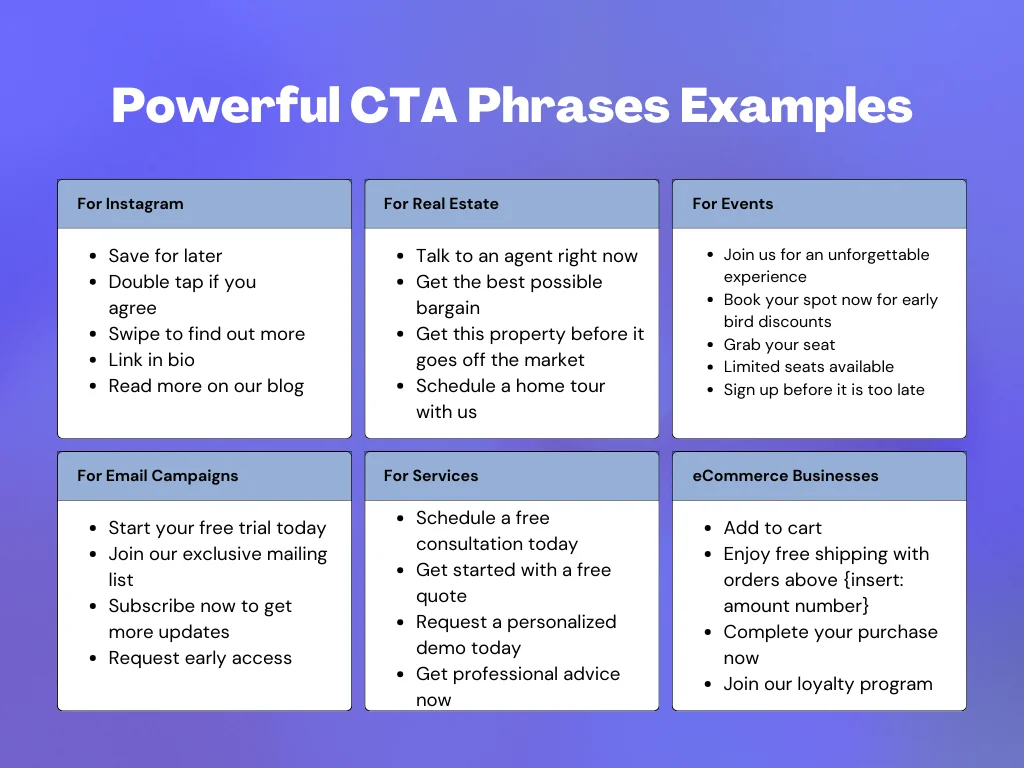 According to research, companies with 10 to 12 landing pages achieved 55% more leads.
According to research, companies with 10 to 12 landing pages achieved 55% more leads.
This entails ensuring you have created strong product or service pages or both.
Of course, getting traffic and ranking highly in SERPs is fantastic. However, driving sales and converting consumers is your ultimate goal.
Thus, consider which pages of your website have products or services. These are typically pages that list the features, benefits, and several calls to action (CTAs) of your goods or services.
Also, they are foundational pages for a lot of B2B businesses.
You must start by optimizing them by taking a close look at internal links, meta descriptions, title tags, and keyword usage.
7. Structure Your Website Using Keyword Clustering
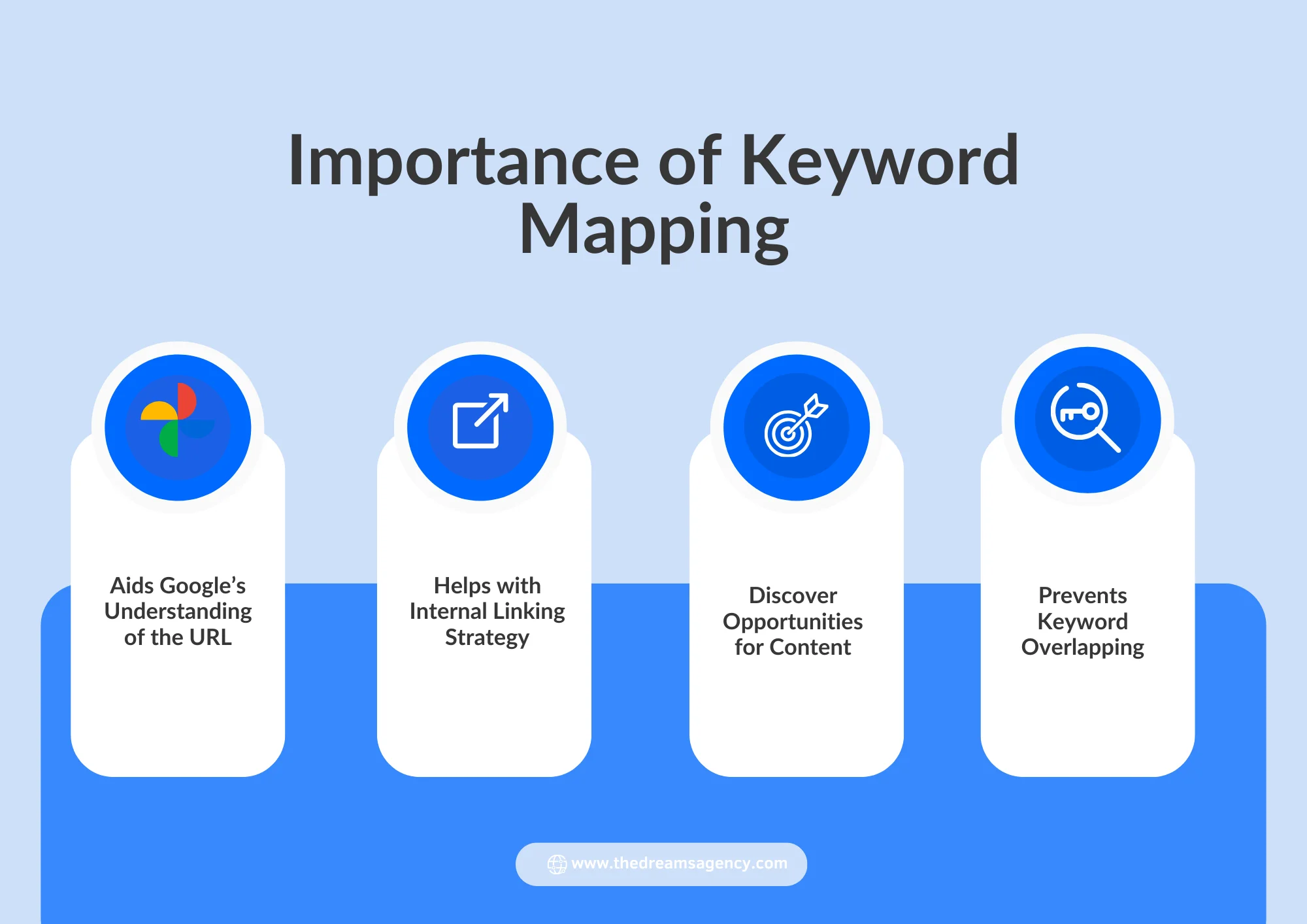 Keyword clustering is assembling related and pertinent phrases from consumer searches.
Keyword clustering is assembling related and pertinent phrases from consumer searches.
Web crawlers and viewers can access a well-organized and streamlined website conveniently.
It has become standard procedure for firms to incorporate keyword clustering into their SEO plan since Google released its Hummingbird update, which directed the crawlers to concentrate on phrases rather than individual keywords.
The following are the steps to use keyword clustering to create a clear website structure:
Divide up the search terms in your list into segments.
Sort key phrases into groups according to synonyms, related terms, phrases, or subtopics. Prioritize grouping three to five keywords.
The number of clusters you construct determines the number of landing pages you generate. Every cluster ought to have a minimum of one landing page.
Link your keyword cluster to a page according to its theme and subject. Utilize this approach to produce and enhance both new and current content.
To make sure the keywords are arranged in the most logical and understandable way possible, go over the clusters and make any necessary refinements, merging or splitting them.
Keyword mapping is a good way to develop a content plan for a B2B SEO strategy as well.
8. Work on Building a Reputation
When coupled with link building, each of the steps of the B2B SEO strategy helps enhance the credibility and industry reputation of your company with clients.
Consumers now anticipate that the top of the SERP page will only include the top companies.
When engaging with potential clients, you can increase your ranking and generate several ongoing benefits by putting a comprehensive B2B SEO plan into practice.
By creating outstanding content that receives backlinks, you may establish your company as a leader in the field.
Customers will view you as a dependable company that they can trust with their business the more that you are mentioned on other reputable websites.
9. Make FAQ Sections To Improve User Experience
Adding FAQ pages to your website is a fantastic idea to add to your B2B SEO strategy.
It is ideal to compile all commonly asked questions into a single, easily accessible place for users.
To guarantee that users receive the answers to their questions, blog entries that discuss providing alternatives or sophisticated product information should include links to the FAQ page.
Remember that these tactics are designed to complement one another, so if you want to boost your SEO efforts, think about using videos or creating backlinks to your FAQ page.
10. Run a Technical SEO Audit For Your B2B SEO Strategy
Technical SEO audits assist you in locating problems with your website that limit its organic visibility.
The steps to carry out a technical site audit are as follows:
Find the crawl errors: To find and rectify any crawl issues, such as broken links, that may be preventing search engines from properly scanning your website, use tools like Google Search Console.
Improve the core web vitals score and page load speed: To increase page load speed, eliminate superfluous coding, optimize graphics, and take advantage of a content delivery network (CDN).
Employ schema markup: Employ organized data to make your site’s structure and content easier for web crawlers to interpret.
Guarantee a mobile-friendly experience: Ensure your website is optimized and mobile-friendly.
Make use of a sitemap: To make it easier for web crawlers to find and navigate the pages on your website, create and submit a sitemap.
Employ 301 redirects: Use 301 redirects to pass link equity, prevent 404 errors, and reroute visitors from outdated or deleted pages to pertinent new pages.
Ensure security: To guard against hacking and other security risks, be sure your website is adequately secured and has a valid SSL certificate.
Related Blog: Essential SEO Tracking Metrics for Business Growth
FAQs
Does email marketing help in B2B SEO strategy?
Although not directly related to SEO, B2B email marketing helps in B2B SEO strategy by increasing brand awareness.
How can I analyze the B2B SEO strategy?
You can use tools like Google Analytics and Google Search Console to get insights on rankings, bounce rate, traffic, CTR, conversions, and dwell time.
How can you get quality backlinks for a B2B SEO strategy?
You can offer your blog post as a link for the resource pages that belong to your industry or ask a publication house to write about you. Also, you can use broken link building to discover opportunities to earn links to your content.
In Conclusion
You can create a B2B SEO strategy for your business with these steps.
You can use different software to improve your SEO strategy and proper guidance.
A B2B SEO strategy is multi-faceted and includes link building, content development, and continual optimization.
If you need help, reach out to a professional today to see results in a few months.

